82 Search Results for motivation
May 16, 2019
by Carole Zangari -
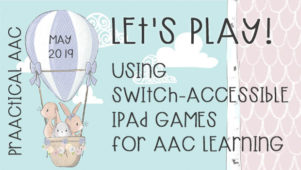
If you’ve been planning to begin using switch-accessible iPad games in your AAC work but haven’t quite gotten it all figured out, this post is for you. We’re delighted to introduce PrAACtical AAC readers to Daniel Rigney, an SLP who with students who have complex communication needs at the Rosedale School in Austin, Texas. Daniel’s professional interests include the AT/AAC Maker Movement (see this post for info on that topic), language development for students with moderate to severe disabilities, and disability rights. He also maintains a YouTube channel, Assistive Technology ATX, with helpful AT content and tips. In this post, Daniel shares the process he uses for integrating iPad games into AAC therapy for students who use switches rather than direct selection. :::::::::::::::::::::::::::::::::::::::::::::::::::::::::::::::::::::::::::::::::::::::::::::::::::: Let’s Play! Using Switch-accessible iPad Games for AAC Learning iPad games can be a great teaching tool for core vocabulary. From having your angry birds “go” to... [Read More...]
November 8, 2018
by Carole Zangari -
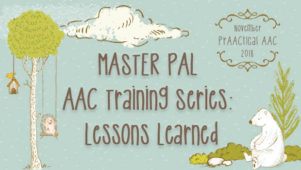
Thanks to all who reached out to express appreciation for Tabi Jones-Wohleber’s training resources in the MASTER PAL series. Many of you have already used the slides, video links, handouts, and discussion points that were shared over the past few months, and others have plans to do so. In this final post, Tabi shares some of the ‘lessons learned’ in creating and utilizing these materials. If you’re new to the series, you can check out each of the 11 modules here. ::::::::::::::::::::::::::::::::::::::::::::::::::::::::::::::::::::::::::::::::::::::::::::::::::::::::::::::::::::::::::::::::::; Over the last 11 weeks, facilitation strategies for communication partners have been shared through the Model as a MASTER PAL series. Model as a MASTER PAL is a framework for supporting communication partners of those who use AAC that evolved in response to the need go beyond the imperative and always present conversations of “use core words” and “model AAC”. It started as a list of ideas to... [Read More...]
November 1, 2018
by Carole Zangari -
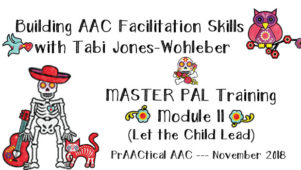
Today, Tabi Jones-Wohleber shares the last module in the MASTER PAL training series, which provides tips and strategies for working with children who don’t yet demonstrate joint attention. This module should take 30-40 minutes to present. Join us next week as we do a final wrap-up with suggestions on using this training series in your AAC work. ::::::::::::::::::::::::::::::::::::::::::::::::::::::::::::::::::::::::::::::::::::::::::::::::::::::::::::::: Model as a MASTER PAL Module 11: Let the Child Lead Facilitator Guidelines It can be really difficult to get communication started with a child who does not demonstrate joint attention. This module explores tips and strategies for traveling with a child on their journey from preoccupation with seeking sensory input/inattention to learning, engaging, and communicating. Because learning emerges from meaningful social emotional experiences, letting the child lead can go a long way toward being invited into their world. Then learning can happen! Here are some things you will need for this... [Read More...]
October 25, 2018
by Carole Zangari -
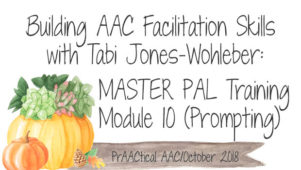
The right types of prompts delivered at the right time in the right amount can be enormously powerful in supporting AAC learners. On the other hand, the wrong type of prompt or prompts that offer too much or too little help can impede learning, self-confidence, and cause other problems as well. In today’s continuation of the Model as a MASTER PAL Training Series, Tabi Jones-Wohleber addresses issues related to prompting. As with the other modules, she provides slides, handouts, video links, discussion points and more. This module should take about 30-40 minutes to present. Looking for the earlier modules in the MASTER PAL Series? Check them out here. :::::::::::::::::::::::::::::::::::::::::::::::::::::::::::::::::::::::::::::::::::::::::::::::::::::::::::::::::::::::::::::::::::: Model as a MASTER PAL Module 10: Appropriate Prompting Facilitator Guidelines What it comes to prompting, it’s important to get it right! Inappropriate prompting can result in decreased quality interactions characterized by prompt dependence, passive engagement, and of course poor use of... [Read More...]
October 18, 2018
by Carole Zangari -
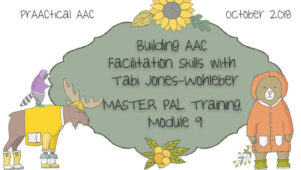
We continue our AAC partner training series, authored by SLP Tabi Jones-Wohleber, with a 60-minute session on presuming potential. In addition to her work with the AT Team for Frederick County Public Schools in Maryland, Tabi serves young children and their families at West Virginia Birth to Three programs. You can see the first 8 modules here. ::::::::::::::::::::::::::::::::::::::::::::::::::::::::::::::::::::::::::::::::::::::::::::::::::::: Model as a MASTER PAL Module 9: Presume Potential Presuming potential is a belief system that influences our words and actions both consciously and unconsciously. As such it cannot be overstated that our words and actions shape the nature and trajectory of opportunities for learning, communicating and engaging for those with whom we interact who use AAC. This module showcases a parent perspective, and utilizes many video examples to invite participants into an honest and reflective conversation on the need to shed assumptions about where an individual’s learning will “max out”. It... [Read More...]
September 20, 2018
by Carole Zangari -
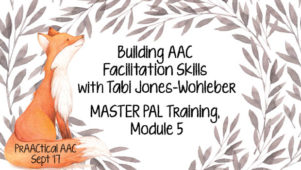
Our AAC Training Series continues today and we are incredibly grateful to Tabi Jones-Wohleber for sharing these presentation materials with us. Today’s training materials center on a topic that is near and dear to my prAACtical heart: Using statements more often than questions. The instructional time for Module 5 is about 90-120 minutes which allows time for discussion and practice. ::::::::::::::::::::::::::::::::::::::::::::::::::::::::::::::::::::::::::::::::::::::::::::::::::::::::::::: Model as a MASTER PAL Module 5: Statements More Than Questions Facilitator Guidelines STATEMENTS MORE THAN QUESTIONS Questions are necessary to help us learn about the things, people, and activities in our environment and beyond. However, interactions heavily weighted with questions do not often yield the quality exchanges required to build relationships, gain understanding, foster autonomous communication or facilitate initiation. This module explores the power of statements (aka nondirective language and descriptive teaching) in shaping meaningful engagement for learning and socially interacting. It includes interactive activities, video links, lots... [Read More...]
September 13, 2018
by Carole Zangari -
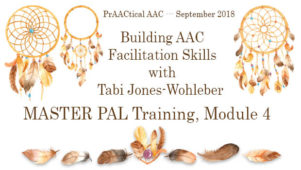
Ready for more AAC training materials? In today’s post, Tabi Jones-Wohleber is sharing another module in the MASTER PAL series. This 30-minute session focuses on the role of multiple modalities in AAC. :::::::::::::::::::::::::::::::::::::::::::::::::::::::::::::::::::::::::::::::::::::::::::::::::::: Model as a MASTER PAL Module 4: Accept Multiple Modalities Facilitator Guidelines We all use multiple modalities to communicate…speech, text, email, a gesture, facial expressions. In much the same way we encourage young children to interact by assigning meaning to their gestures, expressions, and utterances, responding meaningfully to the communicative attempts of those who use AAC validates and encourages the effort. Honor all modalities and respond by modeling AAC as much as possible(regardless of the modality used by the PWUAAC) teaches AAC. Seize the opportunity to teach and expand language. After all, multi-modal communication shapes the human experience. For this training you will need: The Presentation Slides The Presentation Handout The Facilitator’s Guide Warm-up Discussion: Thinking Prompt... [Read More...]
September 6, 2018
by Carole Zangari -
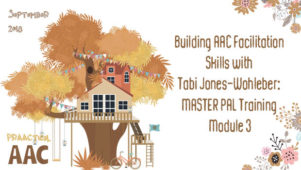
Our training series continues with West Virginia-based SLP Tabi Jones-Wohleber, who works with the AT Team for Frederick County Public Schools in Maryland and provides services to infants and toddlers in the West Virginia Birth to Three programs. In the first two posts, Tabi shared the Overview and Modeling modules and their accompanying resources. In today’s post, the training focuses on an important topic, motivation. ::::::::::::::::::::::::::::::::::::::::::::::::::::::::::::::::::::::::::::::::::::::::::::::::::::::::: Model as a MASTER PAL Module 3: Motivate Facilitator Guidelines Genuine motivation goes well beyond gummies and goldfish; reinforcers are only one small part of the picture as we endeavor to understand what truly drives an individual’s desire to learn and communicate. So much of the time it is the quality of the relationship and the meaningfulness of the interaction. This module discusses the importance of motivation in learning and engaging, whether intrinsic or extrinsic, as well as the undesirable consequences that occur when lack of motivation... [Read More...]
August 30, 2018
by Carole Zangari -
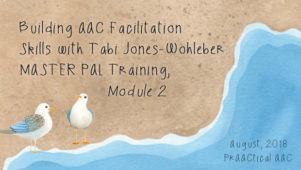
It’s a good day to talk training and we’re incredibly grateful to SLP Tabi Jones-Wohleber for sharing her partner training resources with us. In addition to her work with the AT Team for Frederick County Public Schools in Maryland, Tabi serves young children and their families at West Virginia Birth to Three programs. In the initial post, Tabi introduced the overview module and its accompanying resources. Today, we move onto Module 2 where the focus is on aided language input. ::::::::::::::::::::::::::::::::::::::::::::::::::::::::::::::::::::::::::::::::::::::::::::::::::::::::: Modeling AAC is unquestionably a key component of teaching AAC. Most frequenters of PrAACtical AAC understand that modeling is a naturalistic strategy that functions to support language development by SPEAKING YOUR WORDS. However, misconceptions abound, which often results in modeling opportunities characterized as imitation or compliance tasks. This module unpacks the imperative of modeling to provide a common understanding of what it is (and is not), and why it is a... [Read More...]
July 19, 2018
by Carole Zangari -
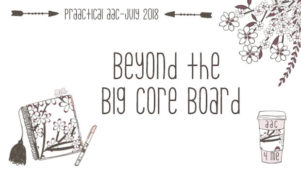
Poster-sized communication boards with core vocabulary have become popular additions to many classrooms and therapy rooms. Having these AAC options so readily accessible made it easier for some therapists, educators, paraprofessionals, and families who were relatively new to AAC, begin to embed it in conversations, lessons, and naturally-occurring routines throughout the day. And that’s a good thing! But…it’s just the beginning. Effective AAC service providers know that there are many more steps on the path to communicative competence. Let’s keep going! One important thing to do at this stage is to customize the AAC display to meet the specific needs and abilities of our individual students. One size doesn’t fit all. If you’re ready to move forward in your own AAC support practices, here are a few questions you can ask yourself to identify some potential next steps. How can I ensure that my beginning communicators have access to words... [Read More...]









